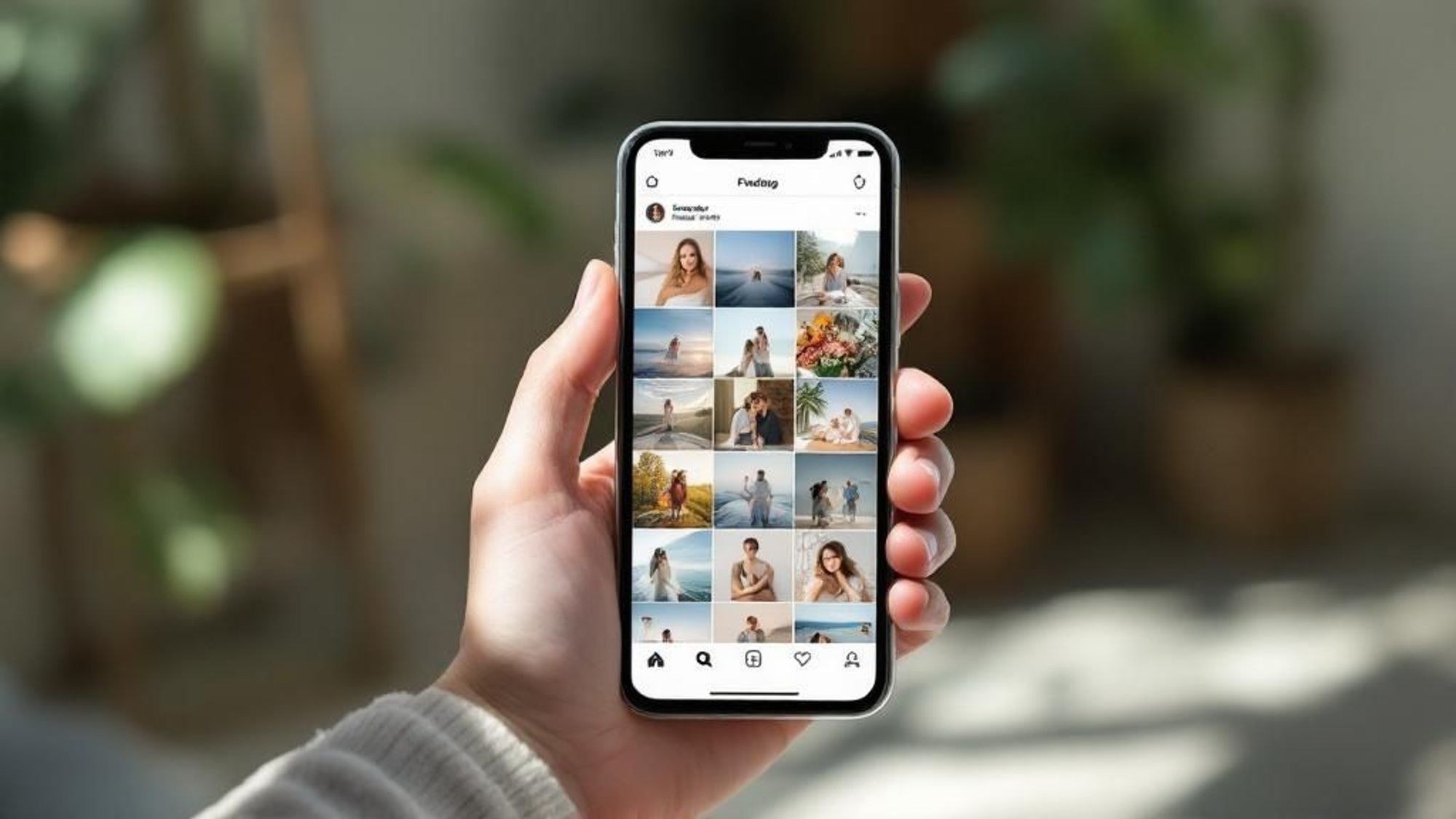Tuesday, August 26, 2025
9 Evergreen Social Media Content Ideas for 2025

In the fast-paced world of social media, the demand for fresh, engaging content is relentless. For marketers, creators, and brands, the question isn't if you should post, but what you should post to capture attention, foster community, and drive results. Staring at a blank content calendar can be daunting, but the solution isn't about finding a single magic formula. It's about building a versatile toolkit of content types that can be adapted, remixed, and scheduled to keep your audience engaged and your brand top-of-mind.
This comprehensive roundup moves beyond generic advice to provide a strategic blueprint of powerful, platform-agnostic social media content ideas. Each idea is broken down with actionable prompts, real-world examples, and practical tips to help you transform your social strategy from reactive to proactive. You will learn how to implement everything from user-generated content campaigns to viral-worthy memes, ensuring your feed never feels stale.
We'll cover specific strategies, including:
- Building trust with behind-the-scenes access.
- Sparking engagement with interactive polls and Q&As.
- Establishing authority through educational how-to guides.
- Connecting emotionally with storytelling and personal narratives.
Whether you're aiming to boost your brand's personality or drive direct sales with compelling product demos, these concepts will equip you to create a dynamic and effective content stream. To further inspire your "Beyond the Feed" strategy, explore these 10 proven ideas for social media content for additional perspectives. Now, let's dive into the strategies that will fill your calendar and fuel your growth.
1. Behind-the-Scenes Content
Behind-the-scenes (BTS) content is one of the most powerful social media content ideas for building trust and humanizing your brand. It pulls back the curtain, offering your audience a genuine, unpolished look at the people, processes, and passion that fuel your work. By revealing what happens outside the public eye, you move beyond being just a product or service and become a relatable entity.
This type of content builds a strong connection by showcasing authenticity. Whether it’s a quick office tour, a glimpse into your creative brainstorming process, or a look at how a product is made from scratch, BTS content makes your audience feel like insiders.

Why It Works
Behind-the-scenes content taps into natural human curiosity. Audiences are tired of overly polished marketing and crave transparency. Showing the "how" behind the "what" validates your expertise and builds an emotional investment in your brand's journey. It’s an effective way to showcase company culture, highlight team members, and demonstrate the care that goes into your final product.
How to Implement It
- Document, Don't Create: Instead of staging perfect shots, capture real moments as they happen. A shaky phone video of your team celebrating a win or a time-lapse of you setting up for a podcast recording often performs better than a scripted ad.
- Show the Process: Break down a complex task into simple, visual steps. A bakery could show the kneading, rising, and baking process. A software company could share screenshots of early wireframes and design mockups.
- Introduce the Team: Feature the people who make your business run. Short interview clips, "day in the life" takeovers on Instagram Stories, or a simple post celebrating a team member's work anniversary can significantly boost engagement.
- Reveal the "Before and After": This classic format is perfect for BTS content. Show a messy studio before a photoshoot, a raw video clip before editing, or a blank page before a design is created. This highlights the effort and skill involved.
When creating this type of raw, in-the-moment content, having a structured review system is still crucial to ensure brand alignment without sacrificing authenticity. Establishing a streamlined content approval workflow helps your team post confidently and consistently.
2. User-Generated Content (UGC)
User-generated content (UGC) is a powerful social media content idea that leverages your audience as your best marketers. It encompasses any content, such as photos, videos, reviews, or social media posts, created by customers or fans that features your brand. By amplifying authentic voices, you build a powerful form of social proof that traditional advertising struggles to match.
This strategy transforms your customers into a community of brand advocates. When someone shares their positive experience with your product or service, it acts as a genuine, trusted recommendation. Campaigns like GoPro’s customer adventure videos or Starbucks’ #RedCupContest showcase how UGC can generate massive engagement and a library of authentic marketing assets.

Why It Works
UGC excels because it is built on trust and authenticity. Consumers are more likely to trust recommendations from peers than from brands directly. Featuring content from real customers makes your marketing feel less like a sales pitch and more like a community celebration. It also provides a steady stream of diverse and relatable content, saving your team significant time and resources while fostering deeper audience connection.
How to Implement It
- Create a Branded Hashtag: Develop a simple, memorable hashtag and encourage your audience to use it when they post about your brand. This organizes all UGC in one place and makes it easy to find.
- Run Contests and Giveaways: Incentivize participation by offering prizes for the best submissions. This can be as simple as a feature on your page or a product giveaway, motivating more users to create and share content.
- Always Ask for Permission: Before reposting anyone’s content, send them a direct message to ask for their permission. It shows respect for their work and ensures you have the rights to share it on your official channels.
- Showcase and Credit Creators: When you feature UGC, always tag and credit the original creator in your caption. This acknowledgment not only rewards the individual but also encourages others to contribute for a chance to be featured.
By incorporating UGC into your strategy, you not only source compelling content but also build a loyal, engaged community around your brand. To get a deeper understanding of how to manage these campaigns, you can explore this new playbook for user-generated content.
3. Educational and How-To Content
Educational and how-to content is a cornerstone of social media content ideas that provide tangible value. It focuses on teaching your audience a new skill, sharing industry-specific knowledge, or offering step-by-step instructions. By becoming a reliable source of information, you position your brand as a trusted expert and build a loyal community that sees you as more than just a seller.
This content type is about empowerment. Whether it’s a detailed tutorial, a quick tip, an industry trend breakdown, or a simple explainer post, you are helping your audience solve a problem or learn something new. Brands like HubSpot and Canva excel at this by consistently offering actionable advice that helps their users succeed.

Why It Works
Educational content directly addresses your audience's pain points, making your brand indispensable. Instead of pushing a product, you are offering a solution for free. This builds immense goodwill and authority, attracting followers who are genuinely interested in your niche. It also has a long shelf life, as high-quality tutorials and guides remain relevant and searchable over time, driving continuous traffic and engagement.
How to Implement It
- Focus on Your Niche: Stick to topics where you have genuine expertise. A fitness coach could share workout form corrections, while a financial advisor could explain complex investment terms in simple language.
- Break It Down: Use simple language and clear visuals like diagrams, screenshots, or short video clips to make complex topics digestible. Carousel posts on Instagram and short-form videos are perfect for this.
- Create Content Series: Develop a multi-part series around a core topic. For example, a "Marketing 101" weekly series can keep your audience coming back for more and build anticipation for future posts.
- Answer Common Questions: Use tools like AnswerThePublic or browse forums like Reddit and Quora to find out what questions your audience is asking, then create content that provides the answers. For comprehensive guides and tutorials, consider transforming your presentations into videos. Learn how to record a Google Slides presentation with voice-over to create engaging explainer content for your audience.
4. Trending Topics and Newsjacking
Capitalizing on trending topics, often called "newsjacking," is a powerful social media content idea for boosting relevance and visibility. This strategy involves inserting your brand into a larger, ongoing conversation by creating timely content related to viral memes, breaking news, or popular cultural events. When done right, it can catapult your brand in front of a massive audience actively engaged with that topic.
This approach allows you to borrow the momentum of a popular subject to generate buzz for your own brand. From a clever tweet about a live TV moment to a TikTok video using a trending audio clip, aligning with what's current makes your brand feel modern, aware, and part of the cultural zeitgeist. It’s about joining the conversation, not interrupting it.

Why It Works
Newsjacking works by tapping into existing audience interest and high search volume. Instead of trying to create a conversation from scratch, you join one that is already happening at scale. This allows smaller brands to gain significant exposure quickly. It demonstrates that your brand is agile, culturally savvy, and has a personality, which helps you connect with audiences on a more human level.
How to Implement It
- Monitor Trends Constantly: Use tools like X (formerly Twitter) Trends, Google Trends, TikTok's "For You" page, and industry news sites to stay on top of what's buzzing. Speed is critical, so continuous monitoring is a must.
- Act Quickly, but Thoughtfully: The window of opportunity for a trend is often very short. You need to create and post content fast, but not at the expense of quality or brand safety. Have a rapid-response approval process ready.
- Ensure Genuine Relevance: The most successful newsjacking feels natural, not forced. Find a clever and authentic link between the trend and your brand's voice, product, or industry. If the connection is a stretch, it's better to skip it.
- Avoid Sensitive or Tragic Events: Never try to capitalize on tragedies, political controversies, or highly sensitive news. This is a fast way to damage your brand's reputation. Stick to lighthearted pop culture, sports, and entertainment moments.
5. Interactive Polls and Q&A Sessions
Interactive content, such as polls and Q&A sessions, is a cornerstone of effective social media engagement. It transforms passive scrolling into active participation by directly inviting your audience to share their opinions and ask questions. This two-way communication is one of the best social media content ideas for building a strong, vibrant community around your brand.
By making your audience part of the conversation, you signal that their voice matters. Whether you're running a simple "This or That" poll on Instagram Stories or hosting an in-depth "Ask Me Anything" (AMA) on LinkedIn, this content makes your followers feel seen, heard, and valued. The result is higher engagement and a more loyal following.
Why It Works
Interactive content leverages the human desire to connect and be understood. It provides instant gratification for the user and invaluable data for the brand. The responses you gather offer direct insight into your audience’s preferences, pain points, and desires, allowing you to tailor future content, products, and services to better meet their needs. This feedback loop is essential for staying relevant and fostering brand loyalty.
How to Implement It
- Ask Relevant, Engaging Questions: Move beyond generic questions. Tie your polls to recent events, industry trends, or specific challenges your audience faces. A software company could ask, "Which new feature would save you the most time: A or B?"
- Host Themed Q&A Sessions: Dedicate sessions to specific topics. For example, a financial advisor could host a Q&A on "Retirement Planning for Freelancers," attracting a highly targeted and engaged audience. Use features like Instagram Live, Twitter Spaces, or TikTok's Q&A sticker.
- Use Polls for Market Research: Let your audience guide your strategy. Ask them what kind of content they want to see next, which product color they prefer, or what topics they want to learn about in your next webinar. Platforms like Twitter are perfect for quick, insightful feedback; you can even learn how to schedule polls on Twitter to maintain consistency.
- Share the Results: Don't let the conversation end with the poll. Create a follow-up post or Story sharing the results and adding your own insights or a "thank you" message. This closes the loop and shows your audience that you were paying attention.
6. Storytelling and Personal Narratives
Storytelling and personal narratives are cornerstones of compelling social media content, transforming abstract brand values into tangible, emotional experiences. This approach uses classic narrative techniques to share brand journeys, customer successes, or personal lessons learned. By wrapping your message in a story, you create a powerful connection that resonates on a deeply human level, making your content memorable and shareable.
This strategy moves beyond simply listing features or benefits; it invites your audience into a shared experience. Whether it's the founding story of your company, a narrative about overcoming a challenge, or a customer's transformation, these stories build empathy and loyalty. It’s a powerful tool for brands like Patagonia, which uses environmental activism narratives to reinforce its mission.
Why It Works
Humans are hardwired for stories. A well-told narrative triggers emotional responses, making information more engaging and easier to remember than dry facts. Storytelling allows you to demonstrate your brand's values in action, rather than just stating them. This authenticity fosters trust and helps your audience see the people and purpose behind your brand, turning passive followers into dedicated advocates.
How to Implement It
- Focus on Transformation: Great stories often involve change. Showcase a "before and after," whether it's a customer's success using your product, your own professional growth, or how your business overcame an obstacle.
- Use a Classic Story Arc: Structure your narrative with a clear beginning (the setup), middle (the conflict or challenge), and end (the resolution or lesson learned). This familiar structure keeps your audience engaged.
- Incorporate Vivid Details: Use descriptive language and sensory details to paint a picture for your audience. Instead of saying "it was a tough project," describe the late nights, the specific problems, and the feeling of the final breakthrough.
- Connect to a Core Value: Every story should have a point that reinforces your brand’s mission. A story about a team member going the extra mile isn't just a feel-good post; it’s a demonstration of your commitment to customer service.
Building a personal brand through storytelling is particularly effective on platforms like LinkedIn. For those looking to master this, learning how to become a LinkedIn influencer can provide a detailed roadmap for turning personal narratives into professional authority.
7. Seasonal and Holiday Content
Seasonal and holiday content is a cornerstone of a relevant social media strategy, allowing your brand to connect with your audience during specific times of the year. This approach aligns your posts with holidays, seasonal shifts, and cultural events, tapping into the collective excitement and conversation already happening. It makes your brand feel timely, current, and part of the community's shared experience.
By participating in these moments, you create opportunities for engagement that feel natural and expected. From a New Year's resolution post to a summer vacation giveaway or a cozy autumn-themed graphic, this type of content capitalizes on the prevailing mood. It’s one of the most reliable social media content ideas for boosting visibility and driving timely interactions.
Why It Works
This strategy works because it leverages existing high-interest periods. Audiences are already primed to engage with content related to major holidays like Christmas or cultural events like the Super Bowl. By joining these conversations, your brand gains relevance and can capture attention more easily than during non-seasonal periods. It also provides a natural framework for promotions, special offers, and themed campaigns.
How to Implement It
- Plan Ahead with a Calendar: Map out major holidays and seasons relevant to your audience at the start of the year. This proactive approach prevents last-minute scrambling and allows for more creative, high-quality campaign development. For a complete guide, explore these social media content calendar ideas from schedulethreads.com.
- Add a Unique Brand Spin: Avoid generic "Happy Holidays" posts. Instead, connect the season to your brand's mission or products. A fitness brand could share tips for staying active during winter, while a B2B software company might post about "spring cleaning" your digital workflow.
- Acknowledge Niche and Lesser-Known Holidays: Don't just focus on the major dates. Fun, unofficial holidays like National Donut Day or World Kindness Day can generate delightful and unexpected engagement, showing your brand’s playful side.
- Think Globally, Act Locally: If you have an international audience, be mindful of which holidays are celebrated in different regions. Tailor your content to specific locations or focus on universally recognized seasons to ensure inclusivity and avoid alienating segments of your audience.
8. Product Demonstrations and Reviews
Product demonstrations and reviews are powerful social media content ideas for moving customers from consideration to conversion. This content shifts the focus from merely describing what a product does to showing how it solves a problem or enhances a user’s life. It provides tangible proof of value and helps potential buyers visualize themselves using the item or service successfully.
By showcasing your product in action, you answer questions before they are even asked and build confidence in your offering. Formats like unboxing videos, tutorials, and customer reviews are essential for educating your audience, highlighting key benefits, and providing the social proof needed to drive purchasing decisions.
Why It Works
This type of content directly addresses the needs of consumers in the evaluation stage of the buyer's journey. They are actively seeking information to justify a purchase, and a clear demonstration is more persuasive than a list of features. Tech reviewers like MKBHD have built entire careers on this principle, proving that audiences crave authentic, hands-on insights. This content bridges the gap between online browsing and an in-store experience, making it a critical tool for e-commerce brands.
How to Implement It
- Focus on Benefits, Not Just Features: Instead of listing technical specifications, demonstrate how a feature makes the user's life easier or better. Show the waterproof phone surviving a real-life splash, not just its IP rating.
- Create "How-To" Tutorials: Develop short videos or guides that teach users how to get the most out of your product. A software company could show a specific workflow, while a beauty brand could create a makeup tutorial for a particular look.
- Showcase Customer Reviews and UGC: Encourage customers to share their own photos and videos using your product. Reposting this user-generated content acts as a powerful, unbiased testimonial and builds community around your brand.
- Produce Unboxing and First Impression Videos: The unboxing experience is a key part of the modern customer journey. Film a satisfying unboxing video that highlights your packaging and the excitement of a new purchase.
9. Memes and Humor Content
Memes and humor content are powerful social media content ideas that tap into internet culture to create highly shareable and relatable posts. This approach leverages popular meme formats, witty commentary, and funny observations about your industry to build a strong, personality-driven connection with your audience. When done right, humor makes your brand more memorable and approachable.
This content works by breaking through the noise of conventional marketing. A well-placed meme or a funny tweet can generate more organic engagement than a polished advertisement because it feels native to the platform. Brands like Wendy's, Duolingo, and Ryan Reynolds' Aviation Gin have mastered this by adopting distinct, humorous personas that resonate deeply with their followers.
Why It Works
Humor is a universal language that lowers people's marketing defenses. It fosters a sense of community by creating an "inside joke" between your brand and your audience. This type of content is incredibly shareable, turning your followers into brand advocates who spread your message for you. It shows that your brand doesn't take itself too seriously, which can be a refreshing and endearing quality.
How to Implement It
- Know Your Audience's Humor: Understand what your followers find funny. Is their humor dry, absurd, witty, or based on niche industry jokes? Analyze comments and popular accounts they follow to get a sense of their style.
- Stay Current, but Act Fast: Meme culture moves quickly. Use formats that are currently trending for maximum relevance, but be prepared for them to become outdated in a matter of days or weeks. Don't use a meme you don't fully understand.
- Adapt Memes to Your Niche: The most effective humor content relates a popular meme format back to a specific pain point, experience, or truth within your industry. This shows you are in tune with both internet culture and your customers' world.
- Maintain Brand Voice Consistency: Your humor should feel like a natural extension of your brand's personality, not a forced attempt to be trendy. A luxury brand's humor will be very different from a fast-food chain's. Test jokes internally to ensure they land correctly.
Social Media Content Ideas: 9-Item Comparison
| Content Type | Implementation Complexity 🔄 | Resource Requirements ⚡ | Expected Outcomes 📊 | Ideal Use Cases 💡 | Key Advantages ⭐ |
|---|---|---|---|---|---|
| Behind-the-Scenes Content | Medium - requires ongoing content creation | Low - minimal equipment, mainly time | Builds trust, emotional connection | Brands wanting authenticity and transparency | Builds trust, low production costs, relatable |
| User-Generated Content (UGC) | Medium - management and curation needed | Low to medium - community management | Increases engagement, free marketing | Brands with active communities, social proof | Free content, social proof, builds community |
| Educational and How-To Content | High - needs expertise and quality production | Medium to high - research and creation | Establishes authority, drives loyalty |
From Ideas to Impact: Scheduling Your Success
You now possess a comprehensive arsenal of social media content ideas, a powerful toolkit designed to break through the noise and forge genuine connections with your audience. We've explored everything from the raw authenticity of behind-the-scenes glimpses and the community-building power of user-generated content to the authority-establishing value of educational posts and the timely relevance of newsjacking. This is more than just a list; it's a strategic framework for a vibrant, dynamic, and effective social media presence.
The true challenge, however, lies not in finding inspiration but in maintaining momentum. The difference between a fleeting moment of engagement and sustained audience growth is consistency. A brilliant idea posted sporadically will never outperform a steady, reliable stream of valuable content.
Translating Ideas into a Cohesive Strategy
The key is to move from a random "what should I post today?" mindset to a structured, strategic approach. Think of the content categories we've covered as different food groups. A healthy diet requires balance, and so does your content calendar. Your goal is to create a well-rounded content mix that entertains, educates, inspires, and converts.
A successful content strategy intentionally weaves these different threads together. You might start the week with an educational carousel, follow up with a humorous meme related to your industry, share a compelling customer story, and then host an interactive Q&A session to close out the week. This variety keeps your feed fresh and appeals to different segments of your audience, preventing content fatigue and maximizing engagement.
Key Takeaway: Your greatest asset isn't a single viral post; it's the cumulative impact of consistently showing up with diverse, high-value content that serves your audience's needs.
The Power of Planning and Batching
This is where strategic planning becomes your superpower. Instead of scrambling for social media content ideas daily, dedicate specific blocks of time to content creation. This practice, known as content batching, dramatically improves efficiency and quality. You can plan your entire month's content grid, ensuring each idea from this list gets its moment to shine.
Consider this workflow:
- Monthly Brainstorm: Review this list and select a mix of content types that align with your upcoming marketing goals. Will you be launching a product? Focus on demos and UGC. Is it a slow month? Lean into storytelling and educational content.
- Content Batching: Dedicate a day to writing all your captions, another to designing all your graphics or editing your videos. This allows you to stay in a creative flow state without constant context switching.
- Scheduling for Success: Load all your prepared assets into a scheduling tool. This is the final, crucial step that guarantees your content goes live at the optimal times, even when you're busy with other tasks.
By adopting this system, you transform content creation from a daily chore into a manageable, strategic function of your business. You free up mental energy to focus on real-time engagement, community management, and analyzing what's working, so you can double down on your most successful strategies. Ultimately, a great list of social media content ideas is only the starting point. The real victory is in building a reliable system that turns those ideas into consistent, impactful results.
Ready to turn these ideas into a flawlessly executed content plan? Schedul is the all-in-one publishing tool that helps you schedule your content across multiple platforms from a single dashboard. Plan your calendar, craft compelling posts with our advanced formatters, and automate your publishing to save time and drive growth. Visit Schedul to take control of your content workflow today.
No credit card required!
